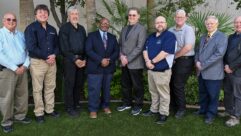The author is principal at Newman-Kees Hertel RF Measurements & Engineering.
It is with some hesitation that I question Larry Langford’s description, “Useless Rule,” regarding the FCC’s mandated, yearly NRSC Occupied Bandwidth and Harmonic Testing.
Without a doubt, every one of us has our own perspective, on just about everything.
More now, then ever before, many a broadcaster’s perspective is motivated by cost. This is completely understandable, but sometimes it is motivated by bad experiences, or whatever our mindset might be.
[Read: Let’s Toss Another Expensive and Useless Rule!]
When “cost” becomes our motivation, often coupled with a partial or incomplete understanding, as to why the FCC has mandated a particular regulation, or when we find it personally difficult to eek out their guidelines and technical reasoning, as to why certain things that broadcasters and their engineers are required to do, by the FCC, in order to satisfy “Consistent Standards of Operation,” then our perspective can sometimes become erroneous. I am no exception!
Regarding Perspective: I will admit to being an engineering service. I will admit to NRSC measurements being one of the sources of our income. I will admit that approx. 65–70% of the stations that we measure are fairly consistent in passing the NRSC Occupied Bandwidth and Harmonic Proof. However, it isn’t always the same stations that fail or pass the yearly NRSC and Harmonic Proof Standards.
Thus, I would ask: Is a 65 to 70% passing grade a “good enough” goal for anyone, or anything?
I would never get on a plane that has a 70% rating. I would not buy a car that has a 70% rating. (“And so it goes” — Linda Ellerbee.)
Sorry Larry, but from my perspective I don’t feel that very many of the stations, that I measure, are ready to go without a (basic) FCC “Yearly Check Up.” Many stations do not have a “Routine Engineer,” or the necessary equipment to assure that their station is meeting FCC standards, and thus those stations are often operating in “Technical Limbo.” Admittedly, they make an honest, daily, effort to stay on the air as best as they can.
Larry, just like you, I too have owned and operated a station and know the nickel and dime (and more) costs that eat at the heels, of broadcasters. All too often it seems that our regulators (local, state and federal) don’t realize that, especially the small-market broadcasters (let us include all broadcasters), are in a delicate and competitive situation. However, this also affects all businesses; not just “broadcasters” and it isn’t going away.
Larry, I do understand your frustration. I wish I had a good answer, to put you at ease with the “mandate.”
Keep in mind that presently the FCC’s yearly mandated “NRSC and Harmonic Proof” is the only documented proof of performance that stations have. It lets the stations know what may need fixing, in order to make their broadcast system compatible with their listeners’ receivers, and at the same time not interfere with other stations.
All things will eventually change — some for better — some for the worse.
Radio World invites industry-oriented commentaries and responses. Send to Radio World.
Here is an aggregation page for this topic.
[Want more information like this? Subscribe to our newsletter and get it delivered right to your inbox.]











